2019 KIA SEDONA heating
[x] Cancel search: heatingPage 420 of 593
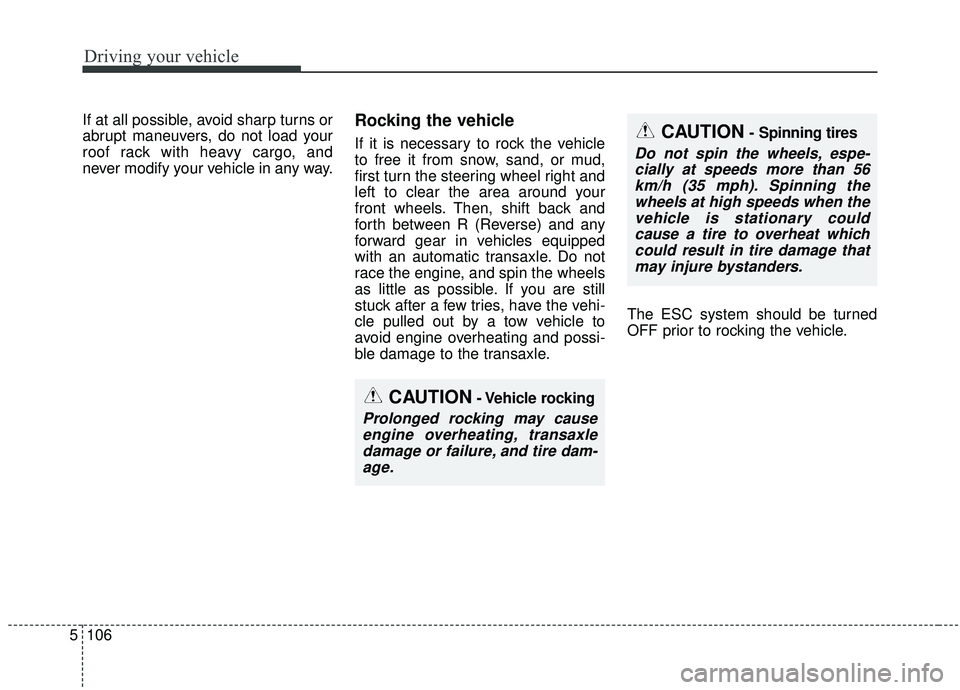
Driving your vehicle
106
5
If at all possible, avoid sharp turns or
abrupt maneuvers, do not load your
roof rack with heavy cargo, and
never modify your vehicle in any way.Rocking the vehicle
If it is necessary to rock the vehicle
to free it from snow, sand, or mud,
first turn the steering wheel right and
left to clear the area around your
front wheels. Then, shift back and
forth between R (Reverse) and any
forward gear in vehicles equipped
with an automatic transaxle. Do not
race the engine, and spin the wheels
as little as possible. If you are still
stuck after a few tries, have the vehi-
cle pulled out by a tow vehicle to
avoid engine overheating and possi-
ble damage to the transaxle. The ESC system should be turned
OFF prior to rocking the vehicle.
CAUTION- Vehicle rocking
Prolonged rocking may cause
engine overheating, transaxledamage or failure, and tire dam-age.
CAUTION- Spinning tires
Do not spin the wheels, espe-cially at speeds more than 56km/h (35 mph). Spinning thewheels at high speeds when thevehicle is stationary couldcause a tire to overheat whichcould result in tire damage thatmay injure bystanders.
Page 423 of 593
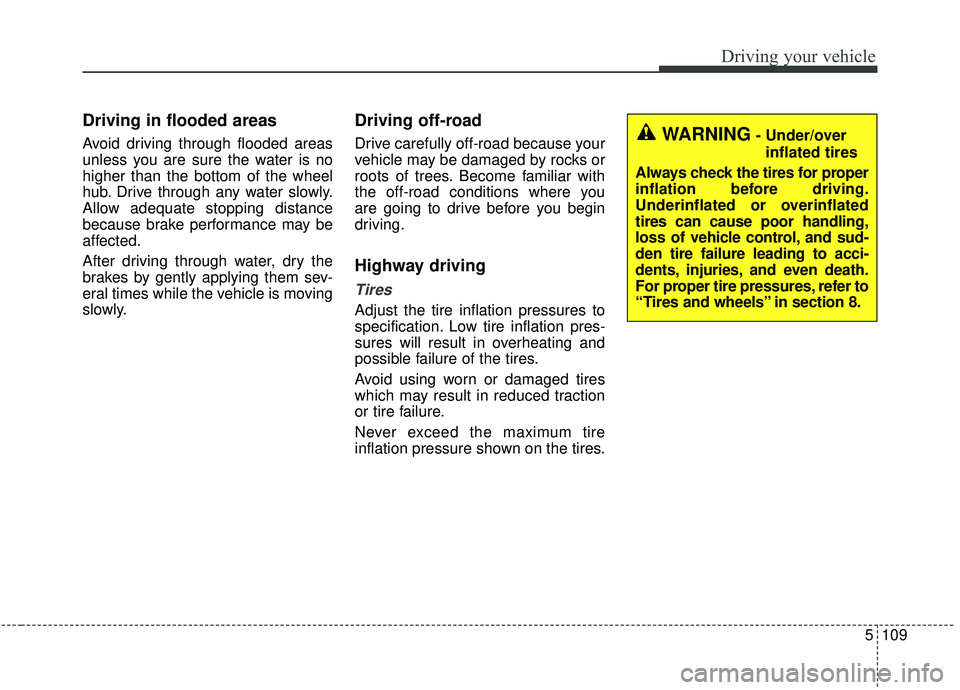
5109
Driving your vehicle
Driving in flooded areas
Avoid driving through flooded areas
unless you are sure the water is no
higher than the bottom of the wheel
hub. Drive through any water slowly.
Allow adequate stopping distance
because brake performance may be
affected.
After driving through water, dry the
brakes by gently applying them sev-
eral times while the vehicle is moving
slowly.
Driving off-road
Drive carefully off-road because your
vehicle may be damaged by rocks or
roots of trees. Become familiar with
the off-road conditions where you
are going to drive before you begin
driving.
Highway driving
Tires
Adjust the tire inflation pressures to
specification. Low tire inflation pres-
sures will result in overheating and
possible failure of the tires.
Avoid using worn or damaged tires
which may result in reduced traction
or tire failure.
Never exceed the maximum tire
inflation pressure shown on the tires.
WARNING- Under/overinflated tires
Always check the tires for proper
inflation before driving.
Underinflated or overinflated
tires can cause poor handling,
loss of vehicle control, and sud-
den tire failure leading to acci-
dents, injuries, and even death.
For proper tire pressures, refer to
“Tires and wheels” in section 8.
Page 424 of 593

Driving your vehicle
110
5
Fuel, engine coolant and engine
oil
High speed travel consumes more
fuel than urban motoring. Do not for-
get to check both the engine coolant
and engine oil.
Drive belt
A loose or damaged drive belt may
result in overheating of the engine.
WARNING- Tire tread
Always check the tire tread
before driving your vehicle.
Worn-out tires can result in loss
of vehicle control. Worn-out tires
should be replaced as soon as
possible. For further information
and tread limits, refer to "Tires
and wheels" in section 7.
Page 432 of 593
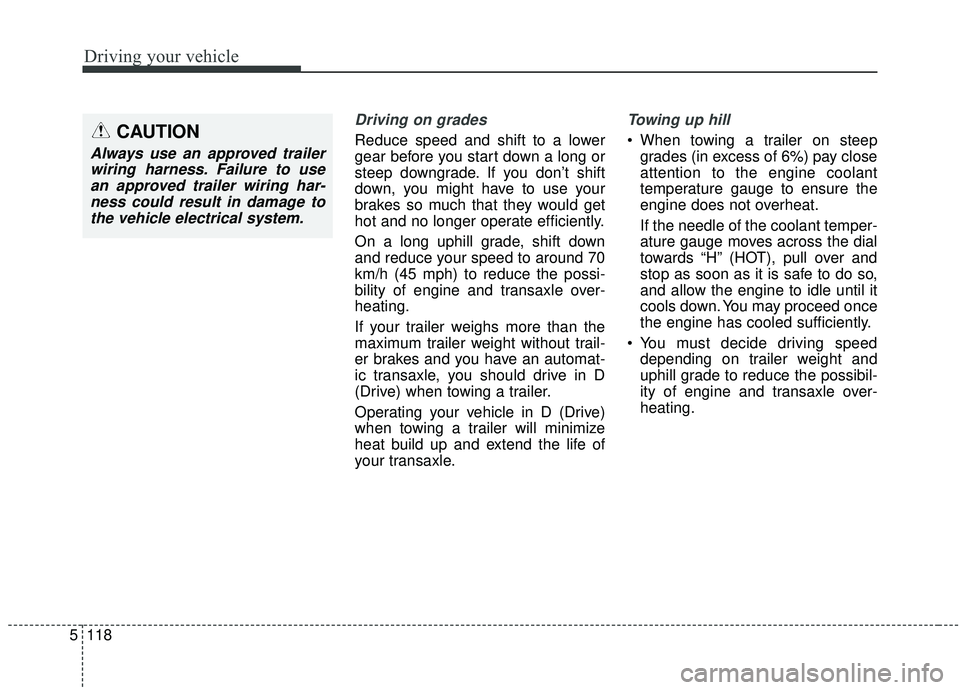
Driving your vehicle
118
5
Driving on grades
Reduce speed and shift to a lower
gear before you start down a long or
steep downgrade. If you don’t shift
down, you might have to use your
brakes so much that they would get
hot and no longer operate efficiently.
On a long uphill grade, shift down
and reduce your speed to around 70
km/h (45 mph) to reduce the possi-
bility of engine and transaxle over-
heating.
If your trailer weighs more than the
maximum trailer weight without trail-
er brakes and you have an automat-
ic transaxle, you should drive in D
(Drive) when towing a trailer.
Operating your vehicle in D (Drive)
when towing a trailer will minimize
heat build up and extend the life of
your transaxle.
Towing up hill
When towing a trailer on steep
grades (in excess of 6%) pay close
attention to the engine coolant
temperature gauge to ensure the
engine does not overheat.
If the needle of the coolant temper-
ature gauge moves across the dial
towards “H” (HOT), pull over and
stop as soon as it is safe to do so,
and allow the engine to idle until it
cools down. You may proceed once
the engine has cooled sufficiently.
You must decide driving speed depending on trailer weight and
uphill grade to reduce the possibil-
ity of engine and transaxle over-
heating.CAUTION
Always use an approved trailerwiring harness. Failure to usean approved trailer wiring har-ness could result in damage tothe vehicle electrical system.
Page 434 of 593
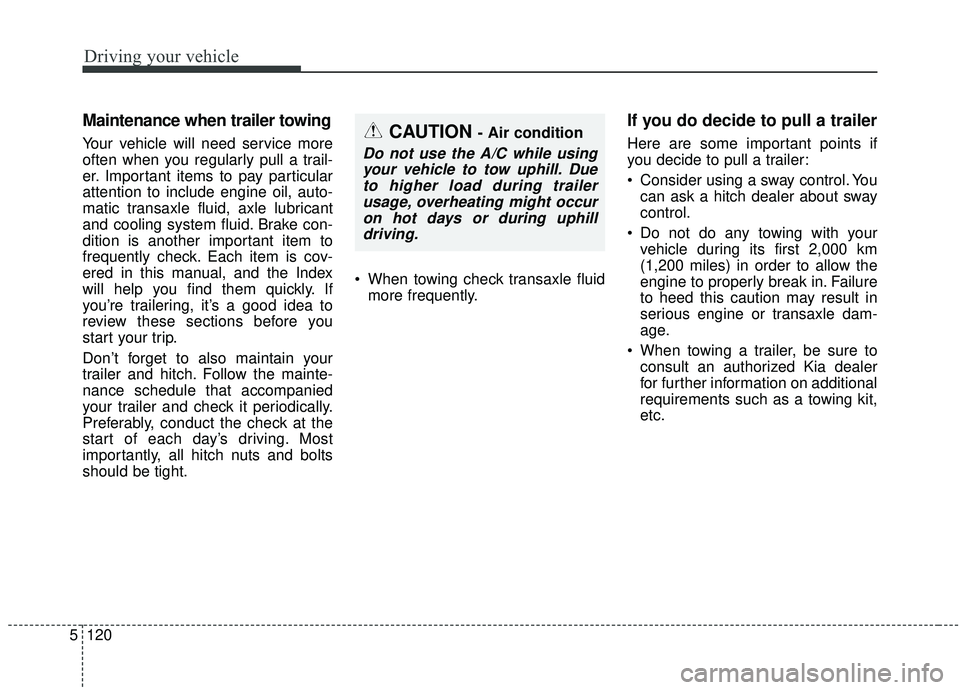
Driving your vehicle
120
5
Maintenance when trailer towing
Your vehicle will need service more
often when you regularly pull a trail-
er. Important items to pay particular
attention to include engine oil, auto-
matic transaxle fluid, axle lubricant
and cooling system fluid. Brake con-
dition is another important item to
frequently check. Each item is cov-
ered in this manual, and the Index
will help you find them quickly. If
you’re trailering, it’s a good idea to
review these sections before you
start your trip.
Don’t forget to also maintain your
trailer and hitch. Follow the mainte-
nance schedule that accompanied
your trailer and check it periodically.
Preferably, conduct the check at the
start of each day’s driving. Most
importantly, all hitch nuts and bolts
should be tight. When towing check transaxle fluid
more frequently.
If you do decide to pull a trailer
Here are some important points if
you decide to pull a trailer:
Consider using a sway control. Youcan ask a hitch dealer about sway
control.
Do not do any towing with your vehicle during its first 2,000 km
(1,200 miles) in order to allow the
engine to properly break in. Failure
to heed this caution may result in
serious engine or transaxle dam-
age.
When towing a trailer, be sure to consult an authorized Kia dealer
for further information on additional
requirements such as a towing kit,
etc.CAUTION - Air condition
Do not use the A/C while usingyour vehicle to tow uphill. Dueto higher load during trailerusage, overheating might occuron hot days or during uphilldriving.
Page 451 of 593
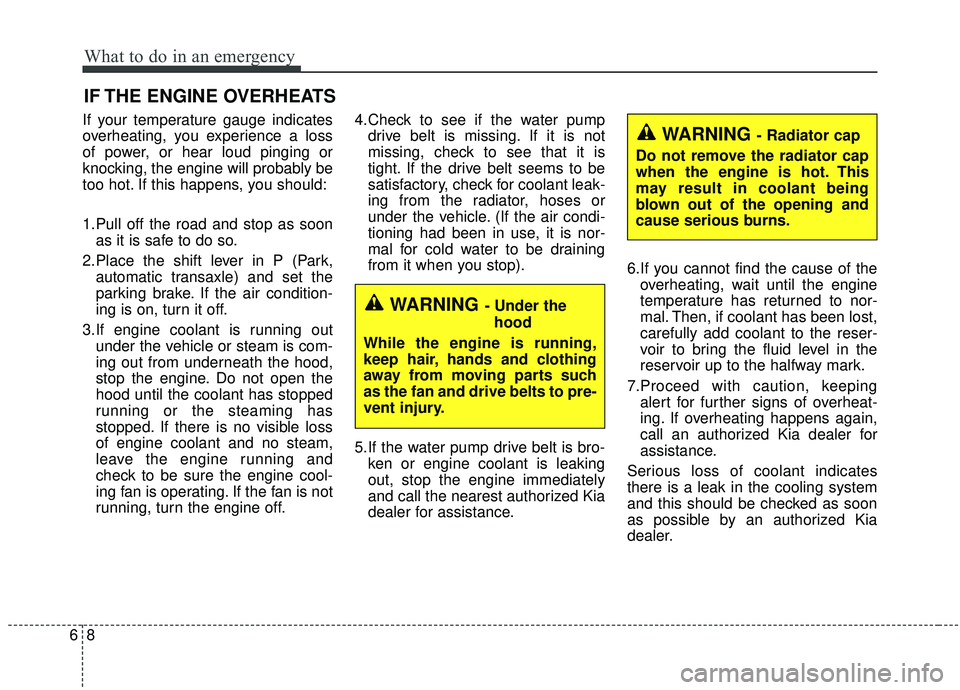
What to do in an emergency
86
IF THE ENGINE OVERHEATS
If your temperature gauge indicates
overheating, you experience a loss
of power, or hear loud pinging or
knocking, the engine will probably be
too hot. If this happens, you should:
1.Pull off the road and stop as soonas it is safe to do so.
2.Place the shift lever in P (Park, automatic transaxle) and set the
parking brake. If the air condition-
ing is on, turn it off.
3.If engine coolant is running out under the vehicle or steam is com-
ing out from underneath the hood,
stop the engine. Do not open the
hood until the coolant has stopped
running or the steaming has
stopped. If there is no visible loss
of engine coolant and no steam,
leave the engine running and
check to be sure the engine cool-
ing fan is operating. If the fan is not
running, turn the engine off. 4.Check to see if the water pump
drive belt is missing. If it is not
missing, check to see that it is
tight. If the drive belt seems to be
satisfactory, check for coolant leak-
ing from the radiator, hoses or
under the vehicle. (If the air condi-
tioning had been in use, it is nor-
mal for cold water to be draining
from it when you stop).
5.If the water pump drive belt is bro- ken or engine coolant is leaking
out, stop the engine immediately
and call the nearest authorized Kia
dealer for assistance. 6.If you cannot find the cause of the
overheating, wait until the engine
temperature has returned to nor-
mal. Then, if coolant has been lost,
carefully add coolant to the reser-
voir to bring the fluid level in the
reservoir up to the halfway mark.
7.Proceed with caution, keeping alert for further signs of overheat-
ing. If overheating happens again,
call an authorized Kia dealer for
assistance.
Serious loss of coolant indicates
there is a leak in the cooling system
and this should be checked as soon
as possible by an authorized Kia
dealer.
WARNING - Under the hood
While the engine is running,
keep hair, hands and clothing
away from moving parts such
as the fan and drive belts to pre-
vent injury.
WARNING - Radiator cap
Do not remove the radiator cap
when the engine is hot. This
may result in coolant being
blown out of the opening and
cause serious burns.
Page 579 of 593
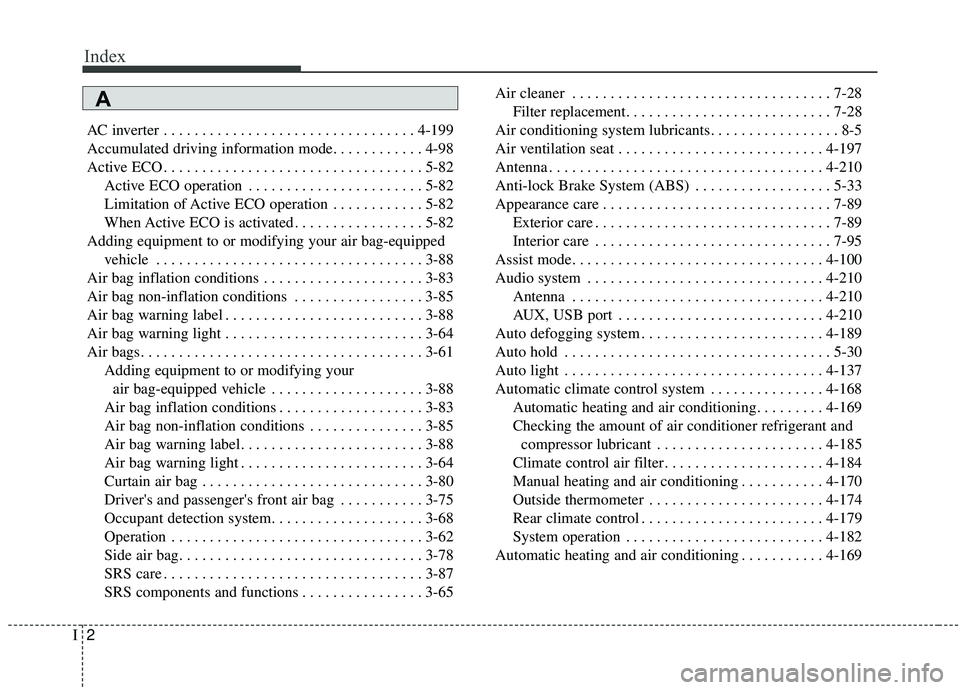
Index
2I
AC inverter . . . . . . . . . . . . . . . . . . . . . . . . . . . . . . . . . 4-199
Accumulated driving information mode. . . . . . . . . . . . 4-98
Active ECO . . . . . . . . . . . . . . . . . . . . . . . . . . . . . . . . . . 5-82\
Active ECO operation . . . . . . . . . . . . . . . . . . . . . . . 5-82
Limitation of Active ECO operation . . . . . . . . . . . . 5-82
When Active ECO is activated . . . . . . . . . . . . . . . . . 5-82
Adding equipment to or modifying your air bag-equipped vehicle . . . . . . . . . . . . . . . . . . . . . . . . . . . . . . . . . . . 3-\
88
Air bag inflation conditions . . . . . . . . . . . . . . . . . . . . . 3-83
Air bag non-inflation conditions . . . . . . . . . . . . . . . . . 3-85
Air bag warning label . . . . . . . . . . . . . . . . . . . . . . . . . . 3-88
Air bag warning light . . . . . . . . . . . . . . . . . . . . . . . . . . 3-64
Air bags. . . . . . . . . . . . . . . . . . . . . . . . . . . . . . . . . . . . \
. 3-61 Adding equipment to or modifying your air bag-equipped vehicle . . . . . . . . . . . . . . . . . . . . 3-88
Air bag inflation conditions . . . . . . . . . . . . . . . . . . . 3-83
Air bag non-inflation conditions . . . . . . . . . . . . . . . 3-85
Air bag warning label. . . . . . . . . . . . . . . . . . . . . . . . 3-88
Air bag warning light . . . . . . . . . . . . . . . . . . . . . . . . 3-64
Curtain air bag . . . . . . . . . . . . . . . . . . . . . . . . . . . . . 3-80
Driver's and passenger's front air bag . . . . . . . . . . . 3-75
Occupant detection system. . . . . . . . . . . . . . . . . . . . 3-68
Operation . . . . . . . . . . . . . . . . . . . . . . . . . . . . . . . . . 3-62
Side air bag. . . . . . . . . . . . . . . . . . . . . . . . . . . . . . . . 3-78
SRS care . . . . . . . . . . . . . . . . . . . . . . . . . . . . . . . . . . 3-87\
SRS components and functions . . . . . . . . . . . . . . . . 3-65 Air cleaner . . . . . . . . . . . . . . . . . . . . . . . . . . . . . . . . . . 7-28\
Filter replacement. . . . . . . . . . . . . . . . . . . . . . . . . . . 7-28
Air conditioning system lubricants. . . . . . . . . . . . . . . . . 8-5
Air ventilation seat . . . . . . . . . . . . . . . . . . . . . . . . . . . 4-197
Antenna . . . . . . . . . . . . . . . . . . . . . . . . . . . . . . . . . . . . \
4-210
Anti-lock Brake System (ABS) . . . . . . . . . . . . . . . . . . 5-33
Appearance care . . . . . . . . . . . . . . . . . . . . . . . . . . . . . . 7-89 Exterior care . . . . . . . . . . . . . . . . . . . . . . . . . . . . . . . 7-89
Interior care . . . . . . . . . . . . . . . . . . . . . . . . . . . . . . . 7-95
Assist mode. . . . . . . . . . . . . . . . . . . . . . . . . . . . . . . . . 4-100
Audio system . . . . . . . . . . . . . . . . . . . . . . . . . . . . . . . 4-210 Antenna . . . . . . . . . . . . . . . . . . . . . . . . . . . . . . . . . 4-210
AUX, USB port . . . . . . . . . . . . . . . . . . . . . . . . . . . 4-210
Auto defogging system . . . . . . . . . . . . . . . . . . . . . . . . 4-189
Auto hold . . . . . . . . . . . . . . . . . . . . . . . . . . . . . . . . . . . 5-\
30
Auto light . . . . . . . . . . . . . . . . . . . . . . . . . . . . . . . . . . 4-13\
7
Automatic climate control system . . . . . . . . . . . . . . . 4-168 Automatic heating and air conditioning. . . . . . . . . 4-169
Checking the amount of air conditioner refrigerant and compressor lubricant . . . . . . . . . . . . . . . . . . . . . . 4-185
Climate control air filter. . . . . . . . . . . . . . . . . . . . . 4-184
Manual heating and air conditioning . . . . . . . . . . . 4-170
Outside thermometer . . . . . . . . . . . . . . . . . . . . . . . 4-174
Rear climate control . . . . . . . . . . . . . . . . . . . . . . . . 4-179
System operation . . . . . . . . . . . . . . . . . . . . . . . . . . 4-182
Automatic heating and air conditioning . . . . . . . . . . . 4-169
A
Page 588 of 593

I11
Index
Scheduled maintenance service . . . . . . . . . . . . . . . . . 7-9
Tire maintenance . . . . . . . . . . . . . . . . . . . . . . . . . . . 7-44
Maintenance schedule. . . . . . . . . . . . . . . . . . . . . . . . . . . 7-9 Maintenance under severe usage conditions . . . . . . 7-13
Normal maintenance schedule . . . . . . . . . . . . . . . . . 7-10
Maintenance services . . . . . . . . . . . . . . . . . . . . . . . . . . . 7-5 Owner maintenance precautions . . . . . . . . . . . . . . . . 7-6
Owner’s responsibility . . . . . . . . . . . . . . . . . . . . . . . . 7-5
Maintenance when trailer towing . . . . . . . . . . . . . . . . 5-120
Manual climate control system. . . . . . . . . . . . . . . . . . 4-152 Checking the amount of air conditioner refrigerant and compressor lubricant . . . . . . . . . . . . . . . . . . . . . . 4-167
Climate control air filter. . . . . . . . . . . . . . . . . . . . . 4-166
Heating and air conditioning . . . . . . . . . . . . . . . . . 4-152
Rear climate control . . . . . . . . . . . . . . . . . . . . . . . . 4-160
System operation . . . . . . . . . . . . . . . . . . . . . . . . . . 4-163
Map lamp . . . . . . . . . . . . . . . . . . . . . . . . . . . . . . . . . . 4-14\
9
Map lamp (Bulb type) bulb replacement . . . . . . . . . . . 7-85
Mirrors . . . . . . . . . . . . . . . . . . . . . . . . . . . . . . . . . . . . \
. 4-74 Inside rearview mirror . . . . . . . . . . . . . . . . . . . . . . . 4-73
Outside rearview mirror . . . . . . . . . . . . . . . . . . . . . . 4-79
Occupant detection system . . . . . . . . . . . . . . . . . . . . . . 3-68
Odometer . . . . . . . . . . . . . . . . . . . . . . . . . . . . . . . . . . 4-10\
3
Oil (Engine) . . . . . . . . . . . . . . . . . . . . . . . . . . . . . . . . . 7-20
One time driving information mode . . . . . . . . . . . . . . . 4-98 Operation (Air bags) . . . . . . . . . . . . . . . . . . . . . . . . . . . 3-62
Outside rearview mirror . . . . . . . . . . . . . . . . . . . . . . . . 4-84
Outside temperature gauge . . . . . . . . . . . . . . . . . . . . . . 4-93
Overheats . . . . . . . . . . . . . . . . . . . . . . . . . . . . . . . . . . . . \
6-8
Owner maintenance . . . . . . . . . . . . . . . . . . . . . . . . . . . . 7-9
Owner maintenance schedule. . . . . . . . . . . . . . . . . . . 7-9
Parking & Tail light . . . . . . . . . . . . . . . . . . . . . . . . . . 4-137
Parking brake . . . . . . . . . . . . . . . . . . . . . . . . . . . . . . . . 7-27 Checking the parking brake . . . . . . . . . . . . . . . . . . . 7-27
Parking brake – Foot type. . . . . . . . . . . . . . . . . . . . . . . 5-23
Parking distance warning . . . . . . . . . . . . . . . . . . . . . . 4-129 Non-operational conditions of parking distance warning. . . . . . . . . . . . . . . . . . . . . . . . . . . . . . . . . 4-131
Operation of the parking distance warning . . . . . . 4-129
Self-diagnosis . . . . . . . . . . . . . . . . . . . . . . . . . . . . . 4-132
Parking distance warning-reverse . . . . . . . . . . . . . . . . 4-125 Non-operational conditions of the parking distance warning-reverse . . . . . . . . . . . . . . . . . . . . . . . . . . 4-126
Operation of the parking distance warning-reverse . 4-125
Parking distance warning-reverse precautions . . . . 4-127
Self-diagnosis . . . . . . . . . . . . . . . . . . . . . . . . . . . . . 4-128
Placing a passenger seat belt into the auto lock mode . 3-55
Position lamp (LED type) replacement (Headlamp Type A) . . . . . . . . . . . . . . . . . . . . . . . . . 7-73
Power brakes . . . . . . . . . . . . . . . . . . . . . . . . . . . . . . . . . 5-21
O
P